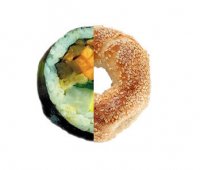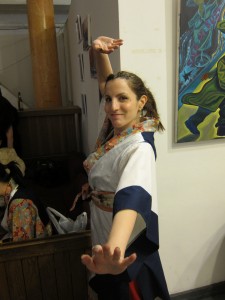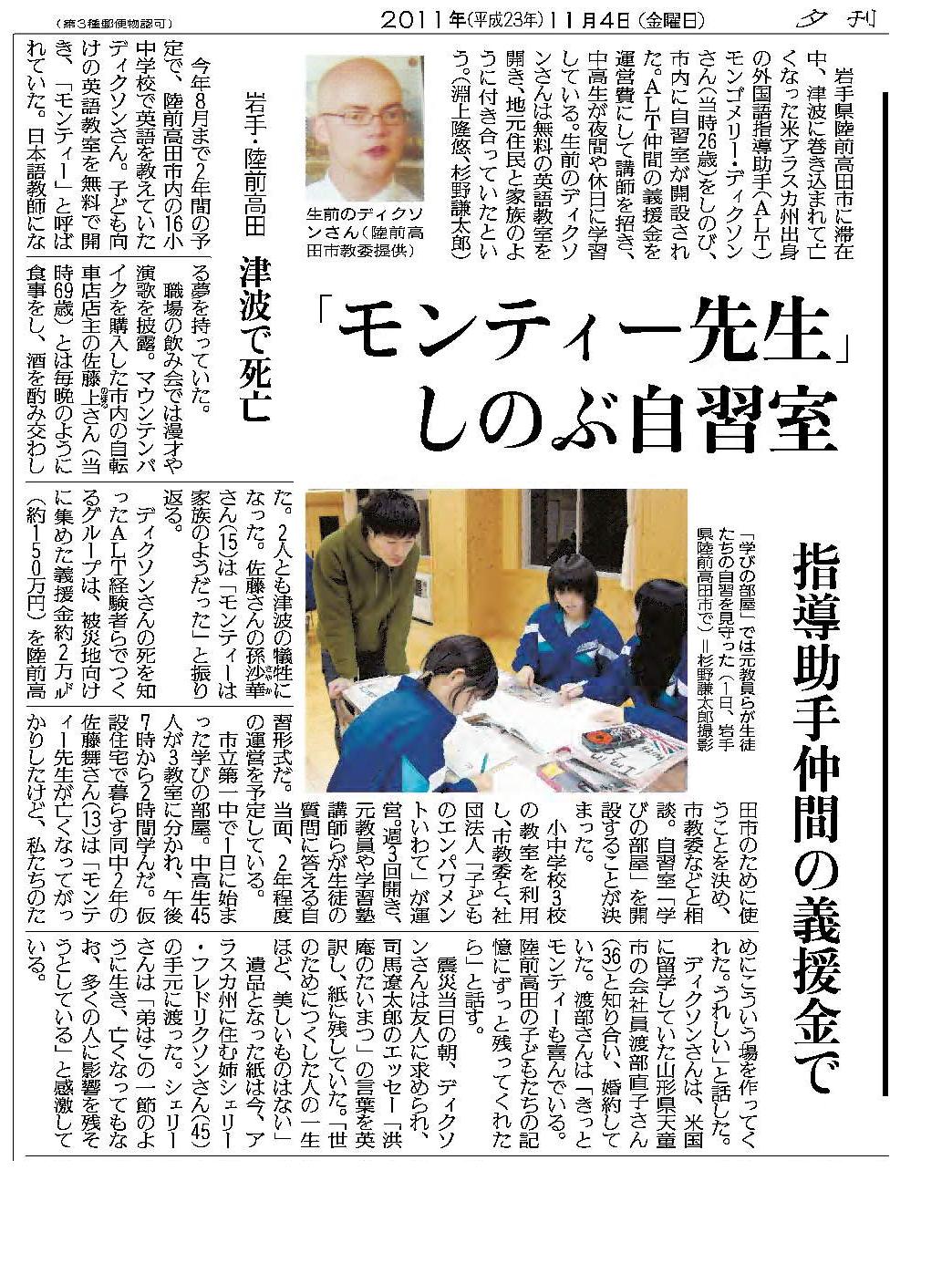“Fiber Futures: Japan’s Textile Pioneers” and “Postcards from Japan: Messages from Tohoku Artists” @ Japan Society until 12/18/2011
Carolyn Brooks (Ishikawa-ken, Kanazawa, 2006-11) is co-author of the blog MadSilence–a cross-cultural blog written with her father–and a current culture/education related job-seeker in the NY area available for full-time or consulting work.
Yesterday I had the opportunity to visit the Japan Society in NYC. Hidden behind an outwardly unassuming facade across the street from the United Nations, The Japan Society has been promoting Japanese-American relations since 1907. Inside, the Society shows its true character as the indoor gardens, water features, and shoji-inspired walkways wow visitors as much as the broad range of classes, exhibitions, and lectures they hold each year.
Currently showing (until December 18th) is “Fiber Futures: Japan’s Textile Pioneers.” It’s a collaboration between The Japan Society and Textile Network Japan along with Tama Art University Museum. As you enter the exhibit, you walk through the first piece of art! The doorway is covered with a noren, or traditional door curtain, made of space-age materials that look like watered silk and gold leaf. It was one great example of how the 30 artists who contributed pieces combined traditional techniques and modern materials to show the versatility and beauty of textiles….
CLICK HERE TO READ THE REST OF THE POST…
Jewpanese – Where Jewish and Japanese converge
 For any Jewish and Jewpanese JETs and alums out there, you may be interested in the “Jewpanese“ Facebook group started by my friend Paul Golin, who serves as Associate Director for the Jewish Outreach Institute and whose wife happens to be Japanese (and an active member of NY de Volunteer!)
For any Jewish and Jewpanese JETs and alums out there, you may be interested in the “Jewpanese“ Facebook group started by my friend Paul Golin, who serves as Associate Director for the Jewish Outreach Institute and whose wife happens to be Japanese (and an active member of NY de Volunteer!)
Here’s the link to “Jewpanese – Where Jewish and Japanese converge“: https://www.facebook.com/JewishJapanese
Posted by Ashley Thompson (Shizuoka-ken, 2008-2010) of Surviving in Japan: without much Japanese and Lifelines columnist for The Japan Times.
I wrote Part 1 of this “Giving Birth in Japan” series last week, so if you haven’t read that already, you may want to before reading Part 2 below.
********
As I was being stitched up, I started shivering uncontrollably. Of course, the temperature in the room had been pretty low as I was sweating and hot throughout the labor and delivery. My husband changed the temp while the nurses helped me change out of my sweaty long t-shirt. (Note: this particular clinic, and probably many others, provide hospital gowns that women typically wear throughout their stay. However, the gowns at this clinic were really uncomfortable and stiff-feeling, so I brought my own clothes to wear for the birth and for the stay. We discussed this with one of the midwives at the clinic beforehand so it wasn’t an issue.)
The nurses also had to put these giant pads on me that were sort of like a diaper as all of the blood came out (sorry, graphic I know), which they changed several times right after I had given birth.
After all this, baby was cleaned up and I got to hold her, and also try nursing her. One important thing I should point out is that depending on where you deliver, the midwives or nurses may have different ideas on the best way to breastfeed. We had been warned beforehand that this clinic wasn’t that great with breastfeeding support, and it seemed like almost every nurse/midwife had a different idea about how it should be done. Initially, they only had the baby feed for a few minutes on each side, and then took her away for some tests. One of the nurses explained that the baby should only eat for 5 minutes on each side and then switch, and many of the others nurses also reemphasized this, but some of them didn’t care about the length of time. And everyone had different ideas of how to manually express milk as well, but a pump was frowned upon).
I was still exhausted and a little out of it for that part, but if I went through this process again I probably would have requested to let her feed longer if she was willing to, instead of just pulling her off after less than 10 minutes. I also would have wanted more skin-to-skin time with the baby, since I was fully clothed again (like I mentioned in the previous post, modesty is preferred) and baby was bundled up as well.
I had to go to the bathroom around this time (it had been a while since I last peed), so asked if I could go. The nurse gave me some cleansing wipes, a pad, etc., and walked with me to the bathroom. I have to tell you, I was so weak at this point, and sore, that it was difficult just getting there. As I was going about my business, I became really faint and lightheaded. My head felt heavy and I had to lean over between my knees.
I should make a brief note that I’ve had various instances happen in my life when I’ve become very lightheaded and faint, and I either nearly pass out or actually do. Usually I try to lay down before I pass out completely, but sometimes it’s been hard to avoid.
So I told the nurse I was lightheaded, and she said we should walk back to the room. I tried standing up, but I found it difficult to stay standing and fell over the sink, grabbing the counter. I willed myself to stay conscious enough to walk back so I could lay down.
That didn’t happen. The nurse called another nurse and they both held onto me as I stumbled my way down the hall. I ended up falling to the floor since I completely lost strength and neither of them could hold me up. There I was laying on the floor in the hallway, just outside the LDR room as one of the nurses called for my husband. The last thing I remember before I blacked out was my husband wrapping his arms around me to pull me up. –– CLICK HERE to read the rest of the post.
Summary of JETAA USA Fund disbursements
***************
Thanks to JETAA USA Country Representative (and JETAA USA Fund Committee member) Megan Miller (Hyogo-ken) for the following summary of the JETAA USA Earthquake Relief Fund’s disbursements. It was originally an e-mail sent to the JETAA USA chapter officers Google Group which has been modified slightly for posting here:
Dear US Chapters,
The fund committee has been hard at work and has finalized the donations for the $76,000+ we have raised so far. I’d like to thank the committee as well as the folks at JETAANY for all of their hard work during the past 8 months, and I’d also like to thank all of you for your amazing fundraising efforts. News of JETAA’s collective, world wide fundraising efforts as JET Alumni is very much on the radar screen in Japan. It is great that we can support the people of Japan and also demonstrate the value of our network and our commitment to Japan at the same time.
To recap the fund committee’s decision, here is where we are allocating the funds raised to date:
1. Hope for Tomorrow – $25,000 (http://hope-tomorrow.jp/)
A major challenge that high school students from the Tohoku region will face is to keep from falling behind students from elsewhere in the country who are studying for their college entrance exams. The students in Tohoku graduating this March had completed their exams by the time of the earthquake, but the ones who will graduate next year are liable to fall behind due to the length of time schools have been shut down, the absence of cram schools and other supplementary educational activities during their senior year, and the trauma and family tragedies that many have to face. On top of this, they need sufficient resources to even take the university exams, which tend to require travel to Tokyo, Sendai or Hokkaido. The exam fees are likely to be waived for many students, but there is no system to support their personal travel, lodging, meals, etc. when they leave their hometowns to take the entrance exams. In many cases, these expenses can easily exceed US$1,000, which will be difficult for families who have lost their homes and businesses to muster.
In response, a group of Tokyo volunteers has launched a new NPO called “Hope for Tomorrow” that plans to help support students by covering these expenses. They have been in touch with the main high schools in Kessennuma and Ishinomaki about this initiative. Kessennnuma had the greatest need, so they have come to an agreement with the high school to start supporting their students, and they hope to expand to other schools, including Ishinomaki’s high school. They are also interested in expanding to Rikuzentakata and open to other suggestions from us about other places. (In May, they tried to speak with the Rikuzentakata authorities as well as those in the neighboring town, Ofunato, where students were attending high school since Rikuzentakata’s high school was badly damaged, but were unable to have discussions due to the overwhelming challenges school officials were facing. However, they hope to try again soon.) In addition to the helping with the exam fees, they also wish to provide mentoring services to the students and other support that can aid them before and after their exams.
Update: They have expanded to Takata High School (the Rikuzentakata HS, although temporarily being operated in an empty school in Ofunato), because of our funds. Takata High School is delighted, and things are all firmed up now. They are also operating in Kessennuma, and might expand into Ishinomaki or elsewhere if there is additional funding.
2. E.Pa+Ch – $25,000 (http://soup1993.com/epatch.html)
E.Pa+Ch stands for Youth Empowerment Iwate (direct translation: Empowerment through Participation and Challenge). This group was created by a professor at Iwate Prefectural University (IPU) who has been active in mobilizing college volunteers to work in the disaster zone through a project called “GingaNet.” The group is planning to launch a major initiative throughout the prefecture to provide tutoring to and study rooms for middle school students who have fallen behind in their studies, with IPU students acting as volunteer tutors. (This may be expanded to high school students taking university entrance exams, in which case professional juku teachers will need to be employed). The board of education expressed support for this, and the IPU professor, Yamamoto-sensei, is going to continue developing the program in consultation with the board. This innovative program was launched on Nov 1, and it possibly will be a model for other programs around Tohoku. CR Jess Wilcox and Fund Committee member Jim Gannon were interviewed regarding our involvement. Read the article here: http://www.yomiuri.co.jp/dy/national/T111104005277.htm
3. Rikuzentakata Board of Education – $10,000
This direct contribution to the BoE will help alleviate some immediate needs of the schools, possibly including the hiring of a second JET for the area. There is currently a JET in RT who replaced Monty Dickson and the BoE would like to hire a second.
4. Taylor Anderson Memorial Fund – $5,000 (http://www.st.catherines.org/tayloranderson )
Many of you are already familiar with the work that the Anderson Family has been conducting. We have made a $5,000 donation to their fund to demonstrate our collective support.
5. Grants for 2-3 JET-related orgs – $10,000+ (To Be Finalized)
We are working with Paul Yoo of volunteerAKITA and Living Dreams who worked with Mike Maher King (Smile Kids Japan). Our grants will help support their grass roots efforts of volunteering in the area, bringing in needed supplies, and ‘filling in the cracks’ where other NGO’s are unable to assist.
TOTAL = $76,000+
Also, many of you might be aware that the JETAA international meeting was held in Tokyo from Oct 21-22. The meeting was covered and televised by NHK news. We also met with various government ministers who thanked us for our efforts to support Japan and asked us for advice on improving the JET program.
After the meeting we volunteered alongside current JETs in Rikuzentakata. We are doing a write up of that emotional experience and will send it to you in the coming days. Being in Rikuzentakata really drove home how important our efforts are. We have the power to get our funds directly in the hands of the people making decisions on the reconstruction effort.
To that end we would like to encourage JETAA chapters to continue fundraising. We now have connections on the ground and can help deploy funds efficiently and effectively. We have been notified that JETAANY will not be able to host the fund next year due to tax reasons, but we will work to find another nonprofit chapter that can help support us. Thank you again JETAANY for all the extra work you took on this year to make the fund a reality!
Lastly, it is always helpful when the JET alumni community is able to remind others of the ongoing needs in Tohoku and share news of JETAA’s accomplishments with others. I strongly encourage each of you and your chapter members to reach out to local news publications, church newsletters, your college and HS alumni magazines, work newsletters, chapter newsletters, etc. A great deal of information can be found on JETwit and the JETAA USA website. You can also contact members of the JETAA USA Fund Committee or local chapter officers if you need additional information or an official representative or spokesperson.
Stay tuned for more detailed information to follow.
A (Culturally) Stimulating Interview with the Insatiable Asa Akira

“I think I have a lot of Japanese culture ingrained in me. Just from being from a Japanese family, living in Japan. The whole ‘respect your elders,’ that, to me, is the main thing that’s different between America and Japan.”
Porn porn
By Michael Karns (CIR Kobe-shi, 2001-02) for JQ magazine. Michael is an avid photographer.
The winner of five AVN Awards (like the Oscars, but without Cuba Gooding, Jr.), Asa Akira returned to the East Coast last weekend for a rare promotional trip. In the spirit of intensifying relations between our nation and Japan, we spoke with the scintillating 25-year-old superstar/native New Yorker about her Japanese roots, her favorite anime films, and the deeper cultural points that America and Japan can swap with each other.
Regarding your Japanese heritage, where is your family originally from?
My mother’s side of the family is from Osaka and my father’s side is from Tokyo, but they live in Yokohama.
You went to an American school growing up.
I did, a very prestigious American private school. It was nice.
When Japanese students relocate to America, it can be difficult adjusting. How was it for you relearning the way of life here?
I was born in New York City and I moved to Japan when I was six, so I already had a little America experience, but it was definitely a huge culture shock. Kids in Japan are really good, even American ones. So coming to New York was like, “Oh my God, these kids are 12 years old and they’re doing drugs!” It was definitely a huge culture shock, and I totally bought into it for a little bit (laughs).
You’ve got an incredible personality…
Thank you.
What do you attribute this to?
I grew up around boys; I think that has a lot to do with my sense of humor. Me and this other girl were always the only two girls in this group of boys, so I think we grew up with a really good sense of humor, you know?
So are you kind of like an otemba (tomboy)?
Yeah (laughs).
That’s my type, by the way.
Oh, good (laughs).
Regarding Japanese culture, what things do you like the most about it? Are there any films or other things that you point to as an inspiration?
I think I have a lot of Japanese culture ingrained in me. Just from being from a Japanese family, living in Japan. The whole “respect your elders,” that, to me, is the main thing that’s different between America and Japan. People in America treat old people like [expletive].
I love my grandmother, but I know what you’re talking about.
(Laughs) And they just don’t listen to older people. I think that’s weird. So that would be the main thing.
I’ll Make It Myself! — Travel Checklist: Local Foods in Hida-Takayama, Part 2
L.M. Zoller (CIR Ishikawa-ken, Anamizu, 2009-11) is the editor of The Ishikawa JET Kitchen: Cooking in Japan Without a Fight. A writer and translator for The Art of Japan: Kanazawa and Discover Kanazawa, ze also writes I’ll Make It Myself!, a blog about food culture in Japan.
Travel Checklist: Local Foods in Hida-Takayama, Part 2
To recap– In September, a friend and I traveled to Takayama, about 3 hours from Kanazawa. Located in Gifu near the border of Nagano, the old towns of Hida (飛騨) and Takayama (高山) are a food tourist’s paradise. Since the town is quite small, most of these foods can be found in stands or restaurants near Takayama Station and nearby morning markets.

CLICK HERE to read the full post.
By Sierra Soleil (Fukushima-ken, 2000-02) for JQ magazine. Sierra works at an ESL school in Manhattan. He enjoys teaching, writing, and riding his bike.
The first weekend of November marked the ninth annual Japan Arts Matsuri (JAM) in New York, this year at the Theater for the New City in the East Village. With about 30 volunteers and a handful of business sponsors, JAM put on an excellent show for roughly a thousand people over the three exciting days.
The entryway and lobby of the theater was crammed with tables selling everything from okashi and yakisoba to clothes and handicrafts, though most people in the know went directly for the Sendai miso cream puffs, and for good reason. There were even two carnival games: a simple one involving throwing a plastic katana at prizes, and an incomprehensible one where people poked little cookies with needles for some reason. Nearly every table was also raising money for earthquake/tsunami relief.
Every day of the three-day matsuri had music and dance performances, but Saturday was Talent Night, where performers could compete for a special invitation to perform at next year’s JAM. I wasn’t sure what to expect from Talent Night, which was good, because it was as wildly erratic as any cross-section of modern Japanese music and dance should be. The first act I caught was Robin’s Egg Blue, a cheerful acoustic pop group. They were followed by a band called Firesign, which was meant to be metal, though any spell they cast dissipated immediately when, as they left the stage, one of the emcees decided to reassure us that they were all very polite in person. After that there were modern and traditional dances, a gospel singer, a karaoke cover of Cee Lo Green’s smash hit (the “Forget You” version, of course), and a fascinating collaboration between a belly dancer and a beatboxer.
The show was billed as being like Amateur Night at the Apollo, and there was some resemblance. The acts were short, and before each intermission the audience chose their favorite via applause. Looking at the lineup, it occurred to me that JAM’s offering was a lot more diverse than anything I’ve seen at Amateur Night. One of the matsuri’s goals is to share Japanese culture with Americans, and the lesson to take from Talent Night is that culturally, the Japanese really are into everything. It also occurred to me that the power to vote by cheering for a performer we liked meant a lot less without the power to impeach them by booing.
I came to Talent Night specifically to meet with JET alumna Kirsten Phillips (Niigata-ken, 2005-08), a member of the Yosakoi Dance Project 10tecomai. The first impression she makes is everything a JET is supposed to be: energetic, cheerful, with a kind of wide-eyed enunciation that makes everything sound exciting. She went directly from teaching in Japan to teaching special education in New York, and it immediately seems like she would be good at it.
JQ Magazine: Film Review – Sion Sono’s ‘Cold Fish’ an Antisocially Acquired Taste

“In the end, Sono really does ask us about our humanity, and what life is about. Sure, he takes the bloody, abusive, rape-filled path, but he does touch on some solid stuff. It’s a lot of big questions wrapped in a gory, misogynistic, boob-exposing gift box.” (Courtesy Salient Media)
By Rick Ambrosio (Ibaraki-ken, 2006-08) for JQ magazine. Rick manages the JET Alumni Association of New York (JETAANY)’s Twitter page and is the creator of the JETwit column Tadaima!
I was hungry, real hungry after work and was about 20 minutes early to the New York Museum of Art and Design near Columbus Circle to see the movie Cold Fish 「冷たい熱帯魚」, so I walked a block to Good Burger and grabbed an overpriced hamburger. As I arrived back to the museum, I sat next to Shree (name changed to protect the innocent) who was midway through a burrito. With minutes left before the movie started, we headed into the museum and down some wooden steps to the theater. Walking in I was pretty surprised; we were only accompanied by seven or eight other patrons. Little did I know that it was a blessing in disguise…fewer people to feel awkward around after the movie.
Oh yes, the movie. How do I write about Cold Fish? It’s a little difficult. I suppose I can do it like this:
Cold Fish is a film directed by the controversial Sion Sono (whose month-long, eight-film retrospective wraps this week at MAD) and stars Denden and Mitsuru Fukikoshi. The film is based on real murders that took place in Fukushima. The story begins well enough: A timid man named Nobuyuki (Mitsuru Fukikoshi) with a rebellious daughter (Hiraki Kajiwara) and a hot trophy wife (gravure idol Megumi Kagurazaka) is feeling disconnected and regretful. They own a tropical fish shop. Through an awkward circumstance they meet Mr. Murata (Denden) and his attractive wife (Asuka Kurosawa), both of whom also own a tropical fish shop.
From there, shit just gets weird. That’s the only way I can explain it, folks. And it wasn’t just because the film cut out four times while we watched it. (Apparently, there were Blu-ray issues…through most of the movie. The museum might want to buy a new player before they hold another festival.) Anyway, Mr. Murata decides to bring Nobuyuki on as a partner, but not before hiring his daughter at his shop and sleeping with his wife (who apparently enjoys rough treatment, to put it mildly).
As Nobuyuki is introduced as the new partner, the old partner finds himself exiting the business via a poisonous death. This is where things kick into the next gear, and Murata forces Nobuyuki to assist with the disposal of the body. The whole body disposal process is presented with great detail. I’m serious about this part—after watching this movie, I am fairly confident that anyone could make a dead body disappear.
The plot then dives deeper and deeper into the dark comedy that is Murata’s utter disregard for human life and the director’s utter disregard for your stomach. By the way, did I mention that this film is very graphically violent? If you aren’t into that kind of thing, find another show; this movie revels in its ability to test what you can deal with gore-wise. If you enjoy severed heads and genitalia being tossed around a bathroom, you’ve found your dream movie.
Job: Weekend position at a freight forwarder (Long Island)
Via Quick USA. Posted by Dipika Soni (Ishikawa-ken, 2003-06). Dipika has recently moved back to London but is interested in hearing about any Japan-related opportunities across the globe.
———————————————————————————————————————————-
***Note: If you apply for this position, please let them know you learned of it from JETwit. Thanks.***
Job Position: Weekend position at a freight forwarder (Long Island)
Job Details:
Job Type: Long-term part time position (2days/week)
Company: An international freight forwarder
Job Title: Import Coordinator
Salary: Min. $14/hr
Shift: Saturday and Sunday. 8 hours per day.
Requirements:
– Must have customer service etiquette
– Must be able to work on both Saturday and Sunday (8 hours per day).
– Prior experience is not required. The training is provided.
– Need to be proficient with PC and MS Word & Excel
– Must be able to commute by a car
Location: Long Island ? Near JFK
———————————————
If you are interested in this opportunity, please send your resume to hoshino@919usa.com
I am looking forward to hearing from you.
Shion Hoshino
Recruiting Consultant
Quick USA, Inc.
Job: Product Manager at Yelp – Japanese Products (San Francisco)
Via JETAA US country rep Mike Shu who works for Yelp. Posted by Dipika Soni (Ishikawa-ken, 2003-06). Dipika has recently moved back to London but is interested in hearing about any Japan-related opportunities across the globe.
———————————————————————————————————————————-
***Note: If you apply for this position, please let them know you learned of it from JETwit. Thanks.***
Job Position: Product Manager – Japanese Products (San Francisco, CA)
Job Details:
At Yelp, we pride ourselves in being a hyper local product. Yelp is already available in nine countries and we’re starting to work on bringing Yelp to Japan. This role will involve customizing the Yelp product to make sure it feels truly local to our users in Japan.
We need a Product Manager who can design beautiful-but-simple features, crank out mockups and is passionate about how culturally unique different countries are. You should be fluent in Japanese and a definite plus is if you currently live in or have spent a large amount of time (at least 10 years) living in Japan.
You will:
Requirements (and we mean it!):
+ Techie Cred: CS or similar degree so you can talk to our enginerds about Python, map reduce jobs, and naive Bayesian algorithms without a translator.
+ i18n Experience: Knowledge of and experience dealing with the challenges that launching a product in multiple languages creates. You will work with our engineering team on optimizing our translation and localization workflows.
+ Passion about the Space: You love the world of social networking, local search and consumer websites.
+ Non-Nerd Empathy: You’re interested in FriendFeed, Twitter, etc. as much as the next nerd, but you also recognize that you’re designing for a non-techie audience.
+ A Conditional Love for Yelp: Like a BFF or a tee ball coach, you should love us but also be able to tell us what we’re doing wrong. You’ll need to be able to dish out the criticism here and take it, too.
+ A Need for Speed: Daily release cycle? Bring it!
Job: Openings at the Consulate General of Japan in Atlanta
Via JET Program Atlanta. Posted by Dipika Soni (Ishikawa-ken, 2003-06). Dipika has recently moved back to London but is interested in hearing about any Japan-related opportunities across the globe.
———————————————————————————————————————————-
***Note: If you apply for this position, please let them know you learned of it from JETwit. Thanks.***
The Consulate General of Japan in Atlanta currently has the following three openings:
Security Assistant/Japanese Citizen Support Service Assistant
The Consulate General of Japan in Atlanta is seeking security assistant/Japanese citizen support services assistant.
Applicants must either be an American citizen or permanent resident, proficient in both Japanese and English, and possess computer skills, especially Microsoft Word and Excel.
Interested parties should send an email and resume to yoshimura@cgjapanatlanta.org.
Employment Opportunity – Consular Section
The Consulate General of Japan in Atlanta is seeking a full-time Staff for the position of Assistant for Consular Section. The candidate must be a U.S. citizen or a U.S. Green Card holder and need to be fluent in Japanese and English. Computer skills (Microsoft Word and Excel etc. preferred) are also required. To apply for this position, please send us your resume to koike@cgjapanatlanta.org.
Employment Opportunity – Driver
The Consulate General of Japan in Atlanta is seeking a driver to operate the Consulate’s passenger van.
Candidate must be a U.S. citizen or a U.S. green card holder, must be fluent in English, possess computer skills (Microsoft Word and Excel etc.), and be able to use a GPS navigation device. A safe driving record is required.
To apply for this position, please send a resume to isoda@cgjapanatlanta.org.
Job: Instructor for Japanese Course (Miami)
Via JET alum Abby Mcbain of the Miami consulate. Posted by Dipika Soni (Ishikawa-ken, 2003-06). Dipika has recently moved back to London but is interested in hearing about any Japan-related opportunities across the globe.
———————————————————————————————————————————-
***Note: If you apply for this position, please let them know you learned of it from JETwit. Thanks.***
Job Position: Instructor for Japanese Course
Job Details:
Walter Kozloski at Miami Dade College, North Campus are looking for an instructor for beginner’s Japanese.
The course will begin in the Spring Semester, which starts in January 2012. Most likely, the
course will be scheduled for 9:00-9:50 am on Mon, Wed, Fri. or 8:25-9:40 on Tue, Thurs.
In order to instruct in the credit programs at Miami Dade College, a Masters degree in Japanese or a Masters degree in a related field with 18 graduate credits of Japanese language is required.
How to apply:
If interested, contact Mr. Kozloski at wkozlosk@mdc.edu with an attached resume as soon as possible.
Daily Yomiuri: Study halls opened in honor of “Monty-sensei” in Rikuzentakata
*******************
Update 11/07/11: The Ministry of Education has apparently been impressed enough by Youth Empowerment for Iwate to send a team to observe them. And fyi, the group now has a website as well: http://soup1993.com/epatch.html
*******************
There’s a nice Daily Yomiuri article (“Study halls opened in honor of ‘Monty-sensei‘”) on Monty Dickson and the contribution JETAA USA will be making to the Japanese non-profit Iwate Youth Empowerment (which is translated in the article below with a different name).
Though not quoted in the article, JETAA USA Fund Committee members Jessyca Wilcox and Jim Gannon (Ehime-ken, 1992-94) were both interviewed for background. Apparently the program launched on November 1 and they were surprised at the level of demand, receiving 100 applicants and 45 students on the first day.
*************************
Study halls opened in honor of ‘Monty-sensei’
http://www.yomiuri.co.jp/dy/national/T111104005277.htm
Takayuki Fuchigami and Kentaro Sugino / Yomiuri Shimbun Staff Writers
RIKUZEN-TAKATA, Iwate–Special study halls providing self-study sessions to primary and middle school students have opened in Rikuzen-Takata to honor an American assistant language teacher who was killed by the March 11 tsunami.
Montgomery Dickson, a native of Alaska, was scheduled to teach English at 16 primary and middle schools in the city for two years until last August.
Dickson, who was called “Monty” by local residents, gave free English classes to children and had a dream of becoming a Japanese-language teacher. At drinking parties with his coworkers, he sometimes performed manzai comedy and sang enka songs.
Noboru Sato, the owner of a bicycle shop in the city that Dickson bought a mountain bike from, was his close friend. They had dinner and
drank together almost every night.
However, both were killed by the tsunami. Dickson died at the age of 26, while Sato was 69 years old.
Sato’s granddaughter Sayaka, 15, recalled that “Monty was like a member of our family.”
After learning of Dickson’s death, a group of former ALTs (JETwit note: The “group” is actually the JETAA USA Earthquake Relief Fund Committee) decided to use about 20,000 dollars (1.5 million yen) of donations they collected for quake-hit areas for projects to support Rikuzen-Takata.
The group talked with the city’s board of education officials about possible ways to use the donations. They agreed to open study rooms called “Manabi no Heya.”
The study halls, operated by the city’s education board and Empowerment through Participation and Challenge (JETwit note: aka Iwate Youth Empowerment), an Iwate Prefecture-based organization, have been opened at three primary and middle schools.
During sessions at the halls, which are open three times a week in the evening and on weekends, students study on their own and can ask questions to former teachers and cram school instructors. The operators intend to run the sessions for two years.
At the city-run Daiichi Middle School, the first Manabi no Heya study session was held Tuesday. A total of 45 students studied for two hours from 7 p.m. in three classrooms.
Mai Sato, 13, a second-grade student at the school who lives in a temporary housing unit, expressed her appreciation. “I was so depressed by the death of Monty-sensei. But [thanks to him] this study hall was opened. I’m happy,” she said.
Naoko Watanabe, 36, an office worker in Tendo, Yamagata Prefecture,
who was engaged to Dickson, expressed her hopes for his legacy.
“I think Monty is happy [to know about the study halls]. I hope Monty lingers in the memory of children in Rikuzen-Takata for a long time,” Watanabe, who once studied in the United States, said.
On the morning of March 11, Dickson was asked by his friend to translate a phrase from the essay “Koan no Taimatsu” (Ogata Koan’s torch), written by historical novelist Ryotaro Shiba (1923-1996) from Japanese into English.
The English translation was left on a piece of paper: “There is nothing as beautiful as dedicating oneself for a cause.”
The translation was given to Shelley Fredrickson, Dickson’s elder sister, who lives in Anchorage, Alaska.
Referring to the phrase, Fredrickson, 45, said, “Monty always made himself available to anyone who needed him.
“I’m so proud of him and all he had accomplished. I’m finding his inspiration is still flowing and continuing to make an impact on people who knew him as well as those that did not.”
(Nov. 5, 2011)
Hibari-sensei: THE LAST DAYBREAK by exist†trace
Jen Wang (Miyagi, 2008-09) is a lab tech in Dallas and a staff writer for the Japanese music website Purple SKY. Her love of cosplay and her junior high school students inspired the name for her own Japanese pop culture blog, Hibari-sensei’s Classroom.
Recently I wrote a review of THE LAST DAYBREAK, the latest EP by exist†trace, for Purple SKY. The all-female J-rock band made their major label debut this past June and are now gearing up for a U.S. tour. They will play in Boston, New York, and Philadelphia, as well as Tekkoshocon in Pittsburg, in March.

THE LAST DAYBREAK opens with a primal call from Jyou, but instead of singing in her trademark growling alto, she keeps her voice light and clear in “Daybreak ~Jyusan gatsu no shikisai.” Unexpected moves like these are the highlight of exist†trace’s new album.
Read the rest of the review here.
“The Law School Bubble” – JET alum evolves into authoritative voice with latest AmLaw article
 Matt Leichter (Saitama-ken 2003-05) continues to evolve as perhaps the authoritative voice on the topic of “The Law School Bubble” through his blog (“The Law School Tuition Bubble“) and most recently with his latest article to appear in The American Lawyer (aka AmLaw Daily) titled:
Matt Leichter (Saitama-ken 2003-05) continues to evolve as perhaps the authoritative voice on the topic of “The Law School Bubble” through his blog (“The Law School Tuition Bubble“) and most recently with his latest article to appear in The American Lawyer (aka AmLaw Daily) titled:
- “Dear Prospective Law Students, Do Not “Reasonably Rely” on Cooley’s “Report One“. http://amlawdaily.typepad.com/amlawdaily/2011/11/dear-prospective-law-students-do-not-reasonably-rely-on-cooleys-report-one.html
- (You can also read his previous AmLaw article titled “Media Outlets Claiming ‘Law Is no Longer a Golden Ticket’ Conceal Decades of a Profession in Decline.”)
Matt’s writing is gaining recognition for not just his thorough yet accessible writing style, but also for his un-lawyerly comfort with statistics and his willingness to push past assumptions.
If any JET alums out there are still contemplating law school, please (I beg you) read some of Matt’s writing first.






